Hyundai Sonata Plug-in Hybrid 2018 Owner's Manual
Manufacturer: HYUNDAI, Model Year: 2018, Model line: Sonata Plug-in Hybrid, Model: Hyundai Sonata Plug-in Hybrid 2018Pages: 552, PDF Size: 18.67 MB
Page 501 of 552
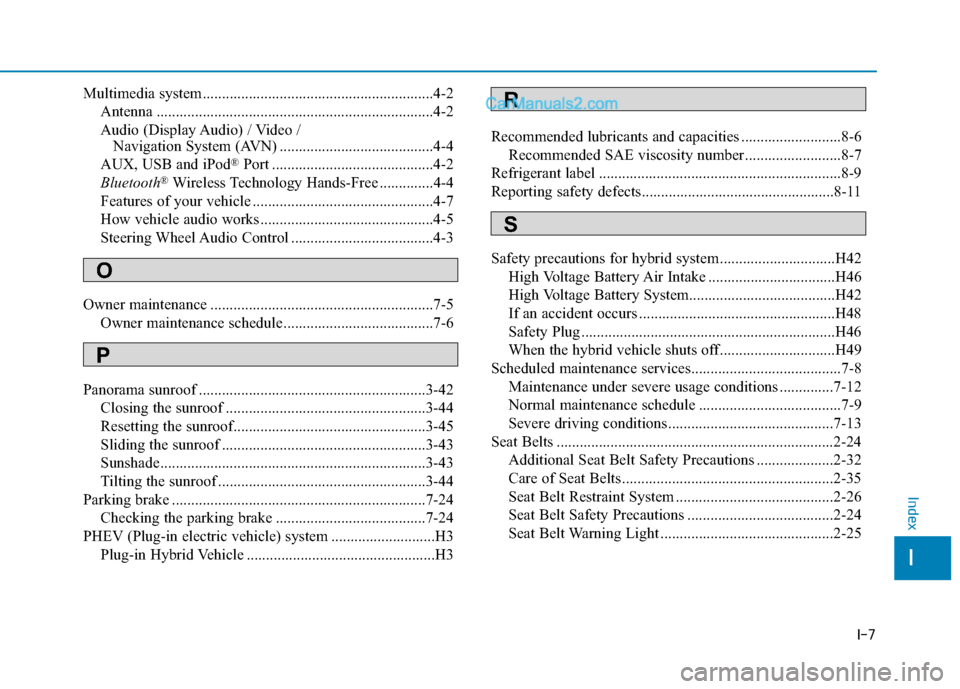
I-7
Multimedia system............................................................4-2Antenna ........................................................................\
4-2
Audio (Display Audio) / Video / Navigation System (AVN) ........................................4-4
AUX, USB and iPod
®Port ..........................................4-2
Bluetooth®Wireless Technology Hands-Free ..............4-4
Features of your vehicle ...............................................4-7
How vehicle audio works .............................................4-5
Steering Wheel Audio Control .....................................4-3
Owner maintenance ..........................................................7-5 Owner maintenance schedule .......................................7-6
Panorama sunroof ...........................................................3-42 Closing the sunroof ....................................................3-44
Resetting the sunroof..................................................3-45
Sliding the sunroof .....................................................3-43
Sunshade.....................................................................3-4\
3
Tilting the sunroof ......................................................3-44
Parking brake ..................................................................7-24 Checking the parking brake .......................................7-24
PHEV (Plug-in electric vehicle) system ...........................H3 Plug-in Hybrid Vehicle .................................................H3 Recommended lubricants and capacities ..........................8-6
Recommended SAE viscosity number .........................8-7
Refrigerant label ...............................................................8-9
Reporting safety defects..................................................8-11
Safety precautions for hybrid system ..............................H42 High Voltage Battery Air Intake .................................H46
High Voltage Battery System......................................H42
If an accident occurs ...................................................H48
Safety Plug ..................................................................H46
When the hybrid vehicle shuts off ..............................H49
Scheduled maintenance services.......................................7-8 Maintenance under severe usage conditions ..............7-12
Normal maintenance schedule .....................................7-9
Severe driving conditions ...........................................7-13
Seat Belts ........................................................................\
2-24 Additional Seat Belt Safety Precautions ....................2-32
Care of Seat Belts .......................................................2-35
Seat Belt Restraint System .........................................2-26
Seat Belt Safety Precautions ......................................2-24
Seat Belt Warning Light .............................................2-25
I
Index
O
R
S
P
Page 502 of 552
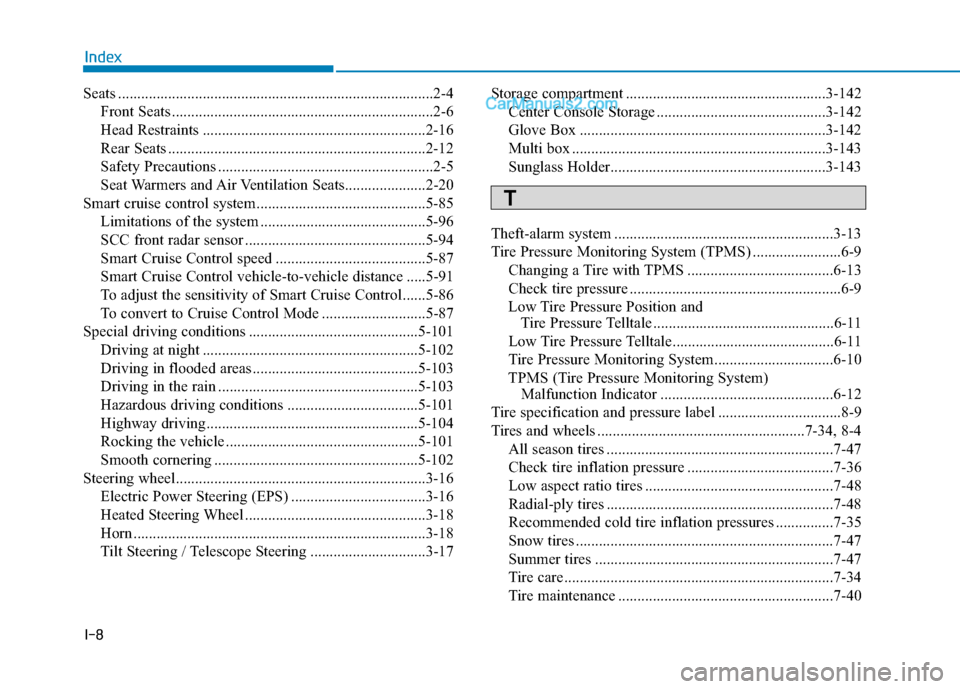
I-8
Seats ........................................................................\
..........2-4Front Seats ....................................................................2-6
Head Restraints ..........................................................2-16
Rear Seats ...................................................................2-12
Safety Precautions ........................................................2-5
Seat Warmers and Air Ventilation Seats.....................2-20
Smart cruise control system............................................5-85 Limitations of the system ...........................................5-96
SCC front radar sensor ...............................................5-94
Smart Cruise Control speed .......................................5-87
Smart Cruise Control vehicle-to-vehicle distance .....5-91
To adjust the sensitivity of Smart Cruise Control ......5-86
To convert to Cruise Control Mode ...........................5-87
Special driving conditions ............................................5-101 Driving at night ........................................................5-102
Driving in flooded areas ...........................................5-103
Driving in the rain ....................................................5-103
Hazardous driving conditions ..................................5-101
Highway driving.......................................................5-104
Rocking the vehicle ..................................................5-101
Smooth cornering .....................................................5-102
Steering wheel.................................................................3-16 Electric Power Steering (EPS) ...................................3-16
Heated Steering Wheel ...............................................3-18
Horn ........................................................................\
....3-18
Tilt Steering / Telescope Steering ..............................3-17 Storage compartment ....................................................3-142
Center Console Storage ............................................3-142
Glove Box ................................................................3-142
Multi box ..................................................................3-143
Sunglass Holder........................................................3-143
Theft-alarm system .........................................................3-13
Tire Pressure Monitoring System (TPMS) .......................6-9 Changing a Tire with TPMS ......................................6-13
Check tire pressure .......................................................6-9
Low Tire Pressure Position and Tire Pressure Telltale ...............................................6-11
Low Tire Pressure Telltale..........................................6-11
Tire Pressure Monitoring System...............................6-10
TPMS (Tire Pressure Monitoring System) Malfunction Indicator .............................................6-12
Tire specification and pressure label ................................8-9
Tires and wheels ......................................................7-34, 8-4 All season tires ...........................................................7-47
Check tire inflation pressure ......................................7-36
Low aspect ratio tires .................................................7-48
Radial-ply tires ...........................................................7-48
Recommended cold tire inflation pressures ...............7-35
Snow tires ...................................................................7-47
Summer tires ..............................................................7-47
Tire care ......................................................................7-\
34
Tire maintenance ........................................................7-40
Index
T
Page 503 of 552
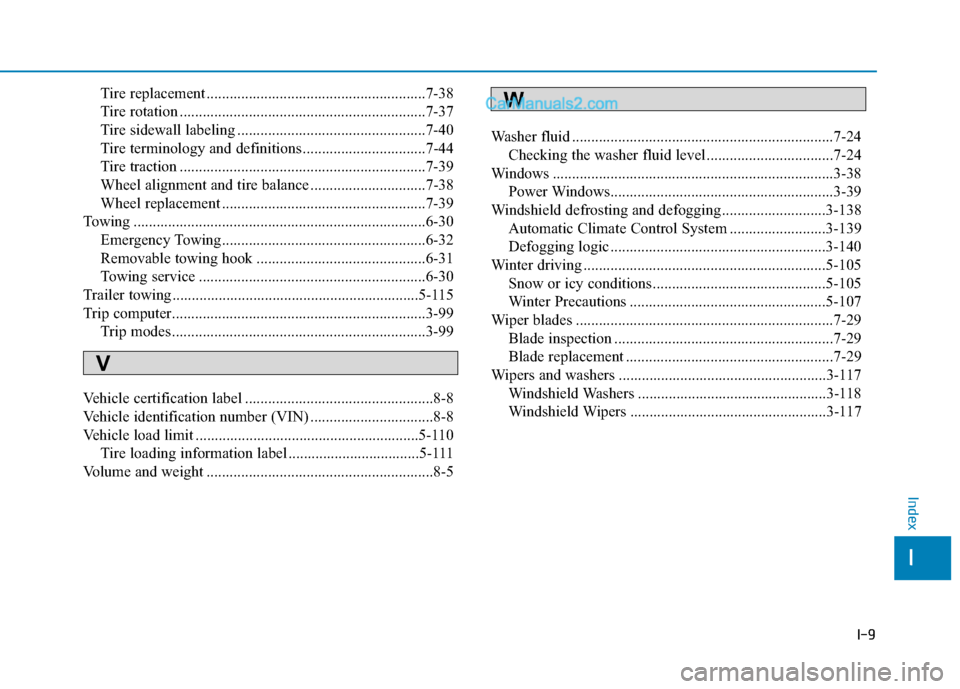
I-9
Tire replacement .........................................................7-38
Tire rotation ................................................................7-37
Tire sidewall labeling .................................................7-40
Tire terminology and definitions ................................7-44
Tire traction ................................................................7-39
Wheel alignment and tire balance ..............................7-38
Wheel replacement .....................................................7-39
Towing ........................................................................\
....6-30 Emergency Towing.....................................................6-32
Removable towing hook ............................................6-31
Towing service ...........................................................6-30
Trailer towing ................................................................5-115
Trip computer..................................................................3-99 Trip modes ..................................................................3-99
Vehicle certification label .................................................8-8
Vehicle identification number (VIN) ................................8-8
Vehicle load limit ..........................................................5-110 Tire loading information label ..................................5-111
Volume and weight ...........................................................8-5 Washer fluid ....................................................................7-24\
Checking the washer fluid level .................................7-24
Windows ........................................................................\
.3-38 Power Windows..........................................................3-39
Windshield defrosting and defogging ...........................3-138 Automatic Climate Control System .........................3-139
Defogging logic ........................................................3-140
Winter driving ...............................................................5-105 Snow or icy conditions .............................................5-105
Winter Precautions ...................................................5-107
Wiper blades ...................................................................7-29 Blade inspection .........................................................7-29
Blade replacement ......................................................7-29
Wipers and washers ......................................................3-117 Windshield Washers .................................................3-118
Windshield Wipers ...................................................3-117
I
Index
V
W
Page 504 of 552
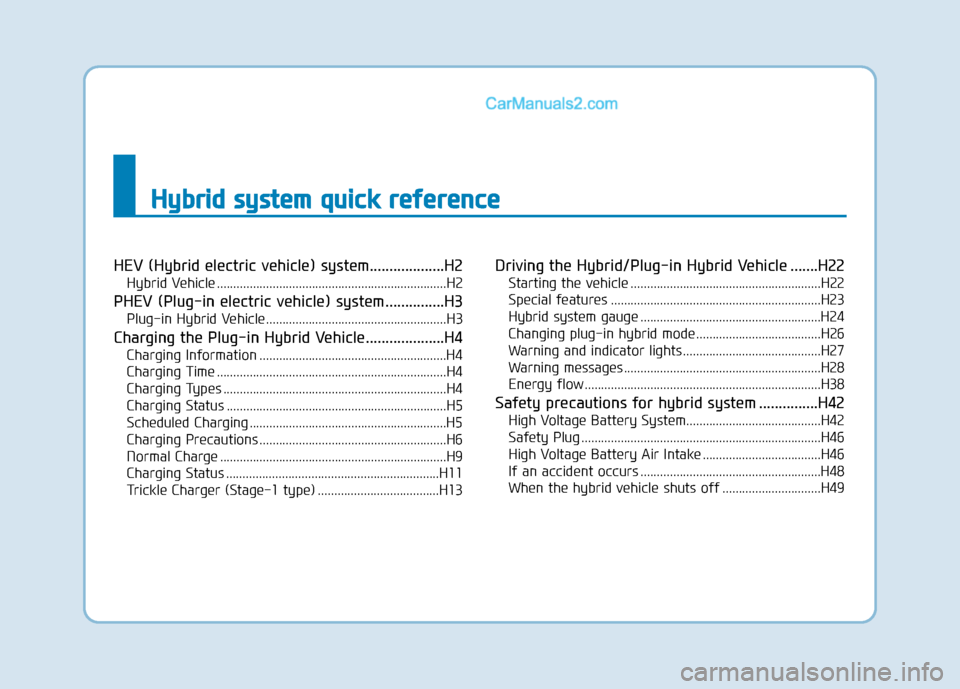
H
Hy
yb
br
ri
id
d
s
s y
y s
st
te
e m
m
q
q u
u i
ic
c k
k
r
r e
e f
fe
e r
re
e n
n c
ce
e
HEV (Hybrid electric vehicle) system...................H2
Hybrid Vehicle ......................................................................H2\
PHEV (Plug-in electric vehicle) system...............H3
Plug-in Hybrid Vehicle.......................................................H3
Charging the Plug-in Hybrid Vehicle....................H4
Charging Information .........................................................H4
Charging Time ......................................................................H4\
Charging Types ....................................................................H4
Charging Status ...................................................................H5
Scheduled Charging ............................................................H5
Charging Precautions .........................................................H6
Normal Charge .....................................................................H9
Charging Status .................................................................H11
Trickle Charger (Stage-1 type) .....................................H13
Driving the Hybrid/Plug-in Hybrid Vehicle .......H22
Starting the vehicle ..........................................................H22
Special features ................................................................H23
Hybrid system gauge .......................................................H24
Changing plug-in hybrid mode ......................................H26
Warning and indicator lights ..........................................H27
Warning messages ............................................................H28
Energy flow ........................................................................\
H38
Safety precautions for hybrid system ...............H42
High Voltage Battery System.........................................H42
Safety Plug ........................................................................\
.H46
High Voltage Battery Air Intake ....................................H46
If an accident occurs .......................................................H48
When the hybrid vehicle shuts off ..............................H49
Page 505 of 552
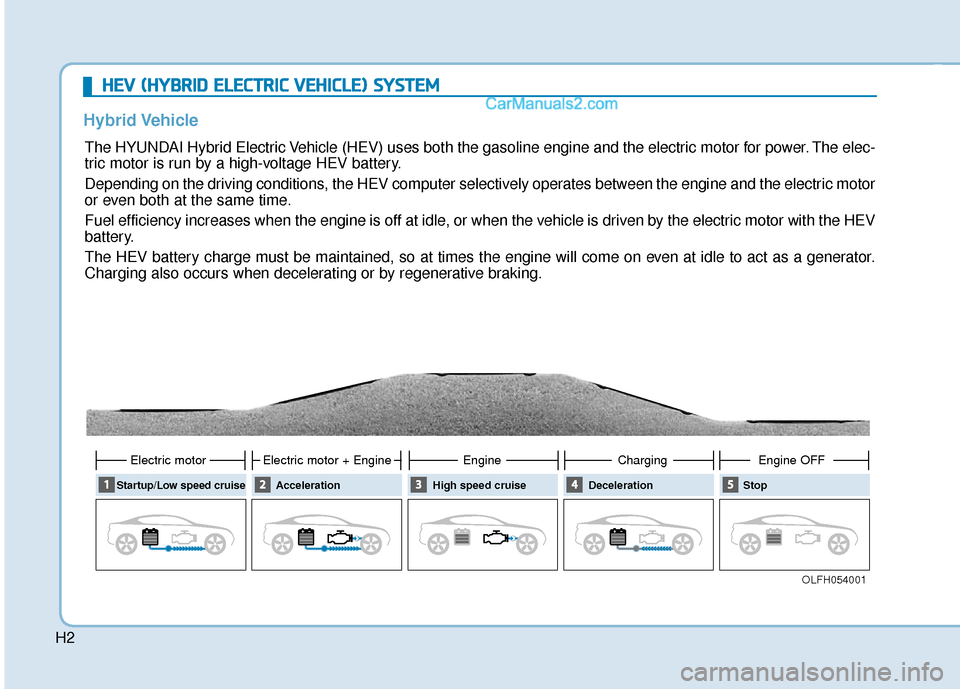
H2
Hybrid Vehicle H
H
E
EV
V
(
( H
H Y
Y B
BR
RI
ID
D
E
E L
LE
E C
CT
T R
R I
IC
C
V
V E
EH
H I
IC
C L
LE
E )
)
S
S Y
Y S
ST
T E
EM
M
The HYUNDAI Hybrid Electric Vehicle (HEV) uses both the gasoline engine and the electric motor for power. The elec-
tric motor is run by a high-voltage HEV battery.
Depending on the driving conditions, the HEV computer selectively operates between the engine and the electric motor
or even both at the same time.
Fuel efficiency increases when the engine is off at idle, or when the vehicle is driven by the electric motor with the HEV
battery.
The HEV battery charge must be maintained, so at times the engine will come on even at idle to act as a generator.
Charging also occurs when decelerating or by regenerative braking.
OLFH054001
Startup/Low speed cruise
Electric motor
Acceleration
Electric motor + Engine
High speed cruise
Engine
Deceleration
Charging
Stop
Engine OFF
Page 506 of 552
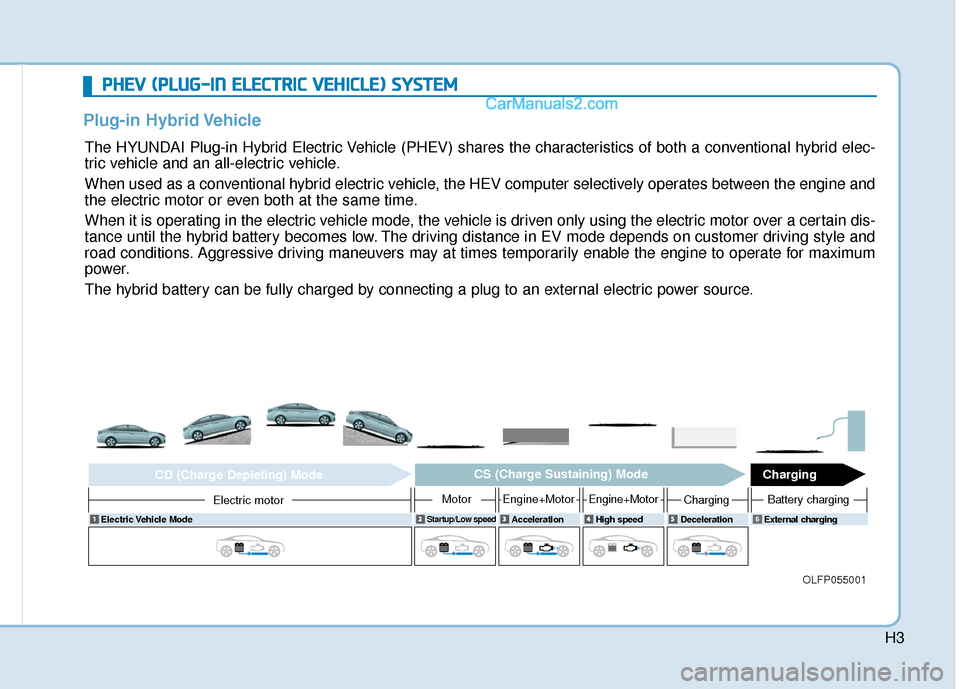
H3
P
PH
H E
EV
V
(
( P
P L
LU
U G
G-
-I
IN
N
E
E L
LE
E C
CT
T R
R I
IC
C
V
V E
EH
H I
IC
C L
LE
E )
)
S
S Y
Y S
ST
T E
EM
M
Plug-in Hybrid Vehicle
The HYUNDAI Plug-in Hybrid Electric Vehicle (PHEV) shares the characteristics of both a conventional hybrid elec-
tric vehicle and an all-electric vehicle.
When used as a conventional hybrid electric vehicle, the HEV computer selectively operates between the engine and
the electric motor or even both at the same time.
When it is operating in the electric vehicle mode, the vehicle is driven only using the electric motor over a certain dis-
tance until the hybrid battery becomes low. The driving distance in EV mode depends on customer driving style and
road conditions. Aggressive driving maneuvers may at times temporarily enable the engine to operate for maximum
power.
The hybrid battery can be fully charged by connecting a plug to an external electric power source.
OLFP055001
Electric Vehicle ModeStartup/Low speedAcceleration High speed Deceleration External charging
Electric motor
CD (Charge Depleting) Mode CS (Charge Sustaining) Mode
Charging
MotorEngine+MotorEngine+MotorChargingBattery charging
6
Page 507 of 552
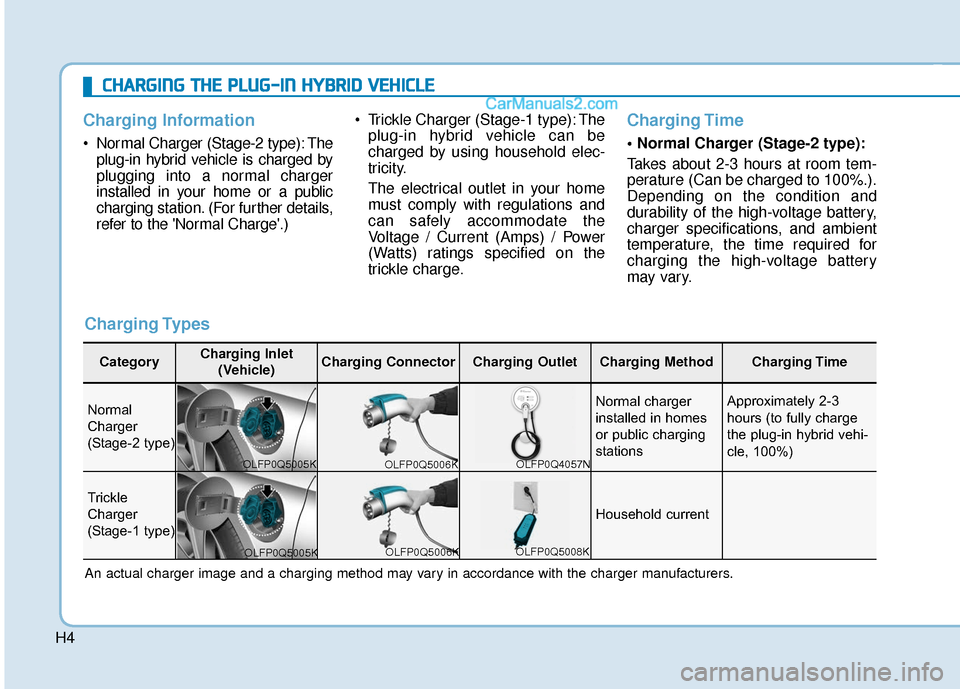
H4
C
CH
H A
AR
RG
G I
IN
N G
G
T
T H
H E
E
P
P L
LU
U G
G-
-I
IN
N
H
H Y
Y B
BR
RI
ID
D
V
V E
EH
H I
IC
C L
LE
E
Charging Information
• Normal Charger (Stage-2 type): The plug-in hybrid vehicle is charged by
plugging into a normal charger
installed in your home or a public
charging station. (For further details,
refer to the 'Normal Charge'.) Trickle Charger (Stage-1 type): The
plug-in hybrid vehicle can be
charged by using household elec-
tricity.
The electrical outlet in your home
must comply with regulations and
can safely accommodate the
Voltage / Current (Amps) / Power
(Watts) ratings specified on the
trickle charge.
Charging Time
• Normal Charger (Stage-2 type):
Takes about 2-3 hours at room tem-
perature (Can be charged to 100%.).
Depending on the condition and
durability of the high-voltage battery,
charger specifications, and ambient
temperature, the time required for
charging the high-voltage battery
may vary.
Charging Types
CategoryCharging Inlet
(Vehicle)Charging ConnectorCharging OutletCharging Method Charging Time
Normal
Charger
(Stage-2 type)Normal charger
installed in homes
or public charging
stations Approximately 2-3
hours (to fully charge
the plug-in hybrid vehi-
cle, 100%)
Trickle
Charger
(Stage-1 type)
Household current
An actual charger image and a charging method may vary in accordance with the charger manufacturers.
OLFP0Q5005K OLFP0Q5006K
OLFP0Q5006K OLFP0Q5008KOLFP0Q4057N
OLFP0Q5005K
Page 508 of 552
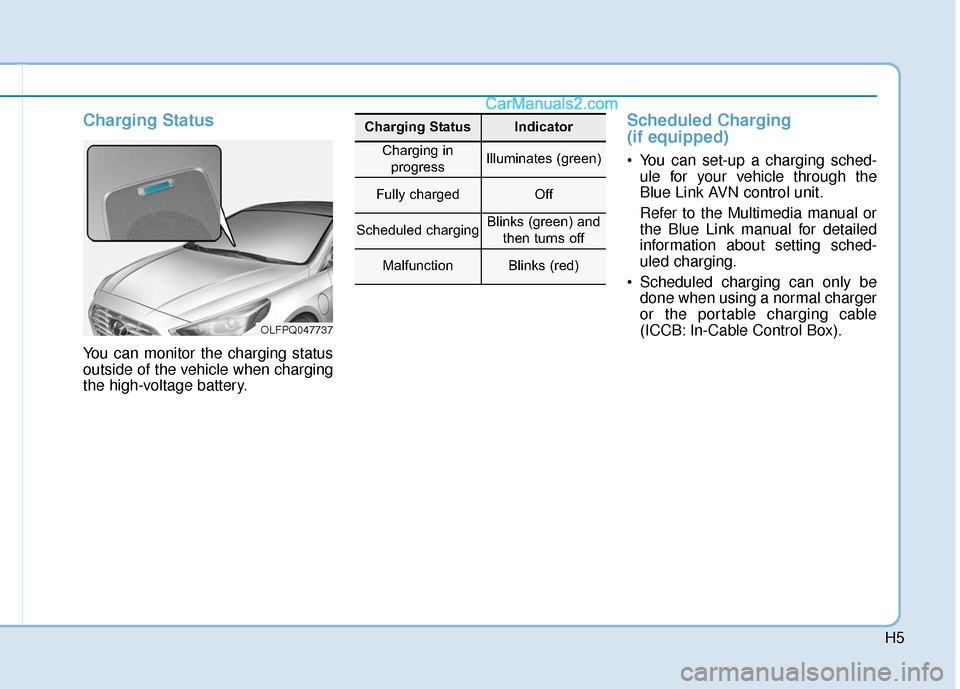
H5
Charging Status
You can monitor the charging status
outside of the vehicle when charging
the high-voltage battery.
Scheduled Charging
(if equipped)
You can set-up a charging sched-ule for your vehicle through the
Blue Link AVN control unit.
Refer to the Multimedia manual or
the Blue Link manual for detailed
information about setting sched-
uled charging.
Scheduled charging can only be done when using a normal charger
or the portable charging cable
(ICCB: In-Cable Control Box).
OLFPQ047737
Charging StatusIndicator
Charging in
progressIlluminates (green)
Fully chargedOff
Scheduled chargingBlinks (green) and then turns off
MalfunctionBlinks (red)
Page 509 of 552
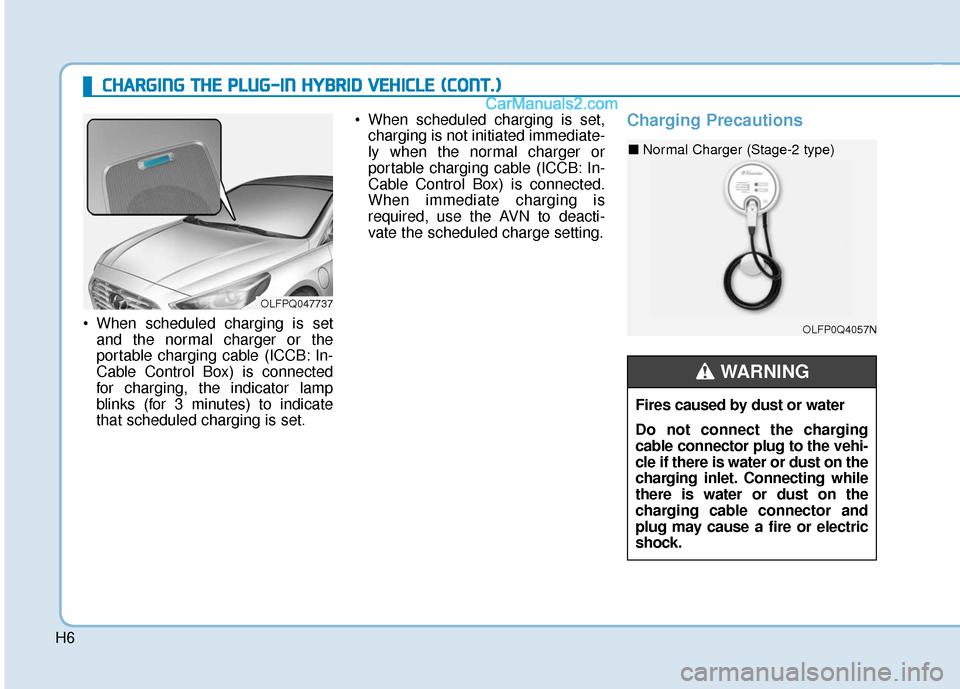
H6
C
CH
H A
AR
RG
G I
IN
N G
G
T
T H
H E
E
P
P L
LU
U G
G-
-I
IN
N
H
H Y
Y B
BR
RI
ID
D
V
V E
EH
H I
IC
C L
LE
E
(
( C
C O
O N
NT
T.
.)
)
When scheduled charging is set
and the normal charger or the
portable charging cable (ICCB: In-
Cable Control Box) is connected
for charging, the indicator lamp
blinks (for 3 minutes) to indicate
that scheduled charging is set. When scheduled charging is set,
charging is not initiated immediate-
ly when the normal charger or
portable charging cable (ICCB: In-
Cable Control Box) is connected.
When immediate charging is
required, use the AVN to deacti-
vate the scheduled charge setting.
Charging Precautions
OLFP0Q4057N
■ Normal Charger (Stage-2 type)
Fires caused by dust or water
Do not connect the charging
cable connector plug to the vehi-
cle if there is water or dust on the
charging inlet. Connecting while
there is water or dust on the
charging cable connector and
plug may cause a fire or electric
shock.
WARNING
OLFPQ047737
Page 510 of 552
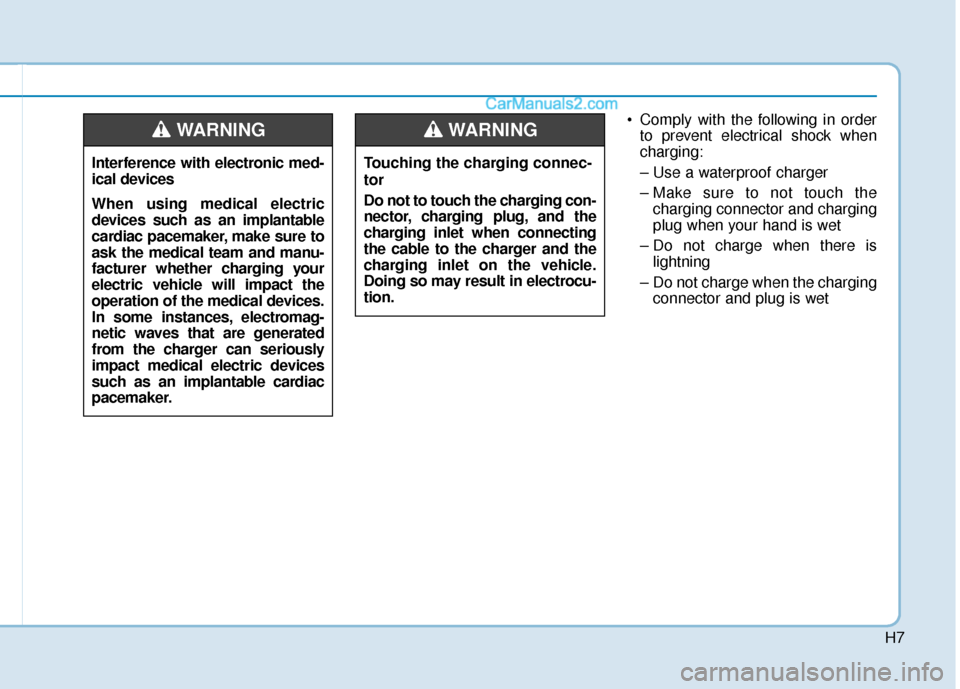
H7
Comply with the following in orderto prevent electrical shock when
charging:
– Use a waterproof charger
– Make sure to not touch thecharging connector and charging
plug when your hand is wet
– Do not charge when there is lightning
– Do not charge when the charging connector and plug is wet
Touching the charging connec-
tor
Do not to touch the charging con-
nector, charging plug, and the
charging inlet when connecting
the cable to the charger and the
charging inlet on the vehicle.
Doing so may result in electrocu-
tion.WARNING
Interference with electronic med-
ical devices
When using medical electric
devices such as an implantable
cardiac pacemaker, make sure to
ask the medical team and manu-
facturer whether charging your
electric vehicle will impact the
operation of the medical devices.
In some instances, electromag-
netic waves that are generated
from the charger can seriously
impact medical electric devices
such as an implantable cardiac
pacemaker.
WARNING